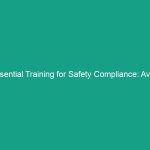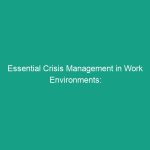Introduction
Good morning team! Today, we’re going to discuss a crucial topic that affects all of us during the colder months: Must-Know Winter Site Safety Guidelines: Avoid These Critical Risks. As winter approaches, it’s essential to recognize the unique challenges our work Environment presents. Understanding and implementing these guidelines is vital for ensuring our Safety and well-being on the job. So, let’s dive into why these Safety Measures are important and how they can protect you and your colleagues.
Understanding Must-Know Winter Site Safety Guidelines
The Must-Know Winter Site Safety Guidelines encompass a set of practices and protocols designed to minimize risks associated with winter conditions. These guidelines are especially important as they directly impact our daily operations and overall safety. Winter can introduce Hazards such as ice, snow, cold weather, and reduced visibility that can lead to accidents if not managed properly.
Many people mistakenly believe that winter safety is only about dressing warmly. While that is important, it is just one aspect of a comprehensive approach to winter site safety. Ignoring other critical risks can lead to serious injuries or even fatalities.
Key Hazards, Risks, and Safety Considerations
Let’s take a closer look at some specific hazards we face during the winter months:
- Slips, Trips, and Falls: Icy walkways and snow-covered surfaces significantly increase the risk of slips and falls.
- Hypothermia and Frostbite: Prolonged exposure to cold can lead to serious health conditions.
- Reduced Visibility: Snow and fog can obscure vision, making it difficult to see hazards or other workers.
- Vehicle Accidents: Driving in winter conditions involves unique risks, including icy roads and poor visibility.
Ignoring these risks can have real-world consequences, such as injuries that could lead to lost work time, increased insurance costs, and even legal liabilities.
Best Practices, Procedures, & Actionable Advice
Now that we understand the risks, let’s focus on the Best Practices and Procedures you should follow:
1. Slips, Trips, and Falls Prevention
- Ensure walkways are clear of ice and snow. Use salt or sand to improve traction.
- Wear appropriate footwear with good traction.
- Walk slowly and carefully, keeping your center of gravity over your feet.
2. Protecting Against Cold-Related Illnesses
- Wear layered clothing to trap body heat.
- Take regular breaks in warm areas to prevent hypothermia.
- Be aware of the signs of frostbite and hypothermia, such as numbness or extreme fatigue.
3. Ensuring Visibility and Safe Driving
- Use high-visibility clothing to make yourself seen.
- Maintain a safe distance from others and drive slowly in poor conditions.
- Ensure that all vehicles are equipped with winter tires and emergency kits.
4. Equipment Safety
- Inspect all equipment for winter readiness, including heaters and snow removal tools.
- Keep emergency equipment accessible at all times.
By following these Best Practices, we can significantly reduce the risks associated with winter conditions. Let’s also look at some real-world examples:
Case Study: The Importance of Preparedness
Last winter, a team member slipped on an icy patch while walking to a job site. Thankfully, they were wearing slip-resistant footwear and were able to catch themselves before falling. However, if proper Precautions had not been taken, the outcome could have been much worse. This incident serves as a reminder to always remain vigilant and prepared.
Regulations, Standards, and Compliance
It’s important to recognize that our safety practices must align with industry Regulations. The Occupational Safety and Health Administration (OSHA) provides guidelines and Standards for Workplace Safety, including those specific to winter hazards. Compliance with these regulations is not only mandatory but also crucial for protecting employees.
By adhering to these standards, we ensure a safer work environment and reduce the potential for accidents. This is not only a legal obligation but a moral one, as we are responsible for each other’s safety.
Employee Engagement & Discussion
Now that we’ve covered a lot of ground, I want to hear from you. What safety challenges have you encountered related to winter conditions? Are there specific practices you believe we could improve upon? Your insights are invaluable as we work together to create a safer workplace.
Conclusion & Key Takeaways
In summary, the Must-Know Winter Site Safety Guidelines are essential for ensuring our safety during the colder months. Remember to:
- Stay alert to the risks of slips, trips, and falls.
- Protect yourself against cold-related illnesses.
- Be mindful of visibility and Safe Driving Practices.
- Ensure compliance with safety regulations.
Let’s commit to prioritizing safety and looking out for one another. Thank you all for your attention and dedication to maintaining a safe work environment! Together, we can navigate the challenges of winter safely and effectively.


